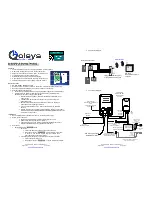
User Interface Basics
Mode Selection
3-2
Pages
Within each mode, the functions and parameters are organized into smaller, related groups that
appear together in the display. Each one of these single-screen groups of parameters is called a
page
. Each mode has what we call an entry level page; itÕs the page that appears when you
select that mode with one of the mode buttons. Within each mode and its editor(s), the various
pages are selected with the navigation buttons. There are many pages, but there are a few
features common to each page. The diagram below shows the entry level page for Program
mode.
ProgramMode||||Xpose:0ST|||<>Channel:1||
!!!!!!!!!!!!!!!!!!@
|200*Analog|Jam||||||
KeyMap|Info|||||||
#
|
202*Heart|Strings|||
|
Grand|Piano|||||
|
#
|
||1|Righteous|Piano|
||||||||||||||||||
#
|||2|Mondo|Bass||||||
||||||||||||||||||
#
|||3|Killer|Drums||||
%%%%%%^%%%%%%^%%%%$
|
|
|4|Wee
p
ing|Gu
i
tar||
Octav-
|
Octav+
|
Panic|
|
View||
|
Chan-|
|
Chan+
The Top Line
On the top line of most pages, thereÕs a reminder of which mode youÕre in and which page
youÕre on. Many pages display additional information in the top line, as well. The Program
mode page above, for example, shows you the current amount of MIDI transposition and the
currently selected MIDI channel. The top line is almost always ÒreversedÓÑthat is, it has a
white background with blue characters.
The Bottom Line
The bottom line is divided into six (sometimes fewer) sets of reversed characters that serve as
labels for the six buttons directly beneath the display. These labelsÑand the functions of the
buttonsÑchange depending on the currently selected page. Consequently the buttons that
select these functions are called ÒsoftÓ buttons.
The Soft Buttons
The soft buttons are called ÒsoftÓ because their functions change depending on the currently
selected mode. Sometimes they perform speciÞc functions, like changing MIDI channels in
Program mode. In the Program Editor, theyÕre also used to move to different pages of
programming parameters.
The Cursor Buttons
To the right of the display are four buttons arranged in a diamond fashion. These are called the
cursor buttons. They move the cursor around the currently selected page, in the direction
indicated by their labels. The cursor is is a highlighted (reversed) rectangle (sometimes itÕs an
underscore). It marks the value of the currently selected parameter.
Programming the K2vx involves selecting various parameters and changing their values.
Parameters are selected by highlighting their values with the cursor. The highlighted value can
be changed with any of the data entry methods described in the data entry section below.
Содержание K2500RS
Страница 12: ...Table of Contents TOC 12...
Страница 16: ...Introduction How to use this manual 1 4...
Страница 32: ...User Interface Basics The Panel Play Feature K2vxR 3 8...
Страница 106: ...Effects Mode and the Effects Editor Configurations and Parameters 9 24...
Страница 186: ...Song Mode Recording Multi timbral Sequences via MIDI 12 52...
Страница 304: ...DSP Functions Hard Sync Functions 14 52...
Страница 394: ...Programs Setups and Keymaps K2500 ROM Keymaps 21 12...
Страница 402: ...LFOs LFO Shapes 23 4...
Страница 406: ...Note Numbers and Intonation Tables List and Description of Intonation Tables 24 4...
Страница 434: ...DSP Algorithms 26 14...
Страница 450: ...MIDI and SCSI Sample Dumps SMDI Sample Transfers 29 8...
Страница 464: ...Glossary 31 6...
Страница 490: ...K2vx Program Farm VOX K25 Appendix A 22...
Страница 494: ...K2vx Compatibility Converting programs from the K2vx to K2000 Appendix B 4...
















































